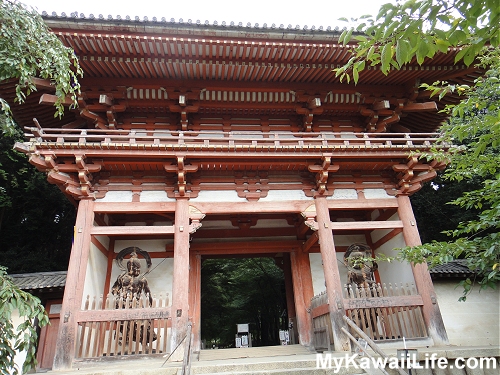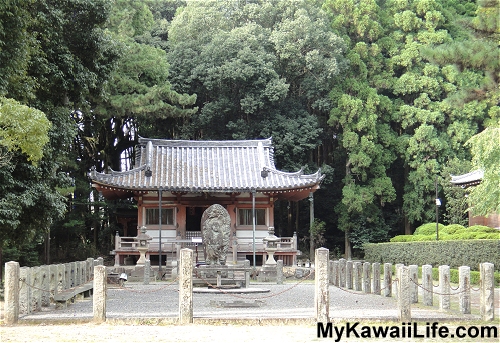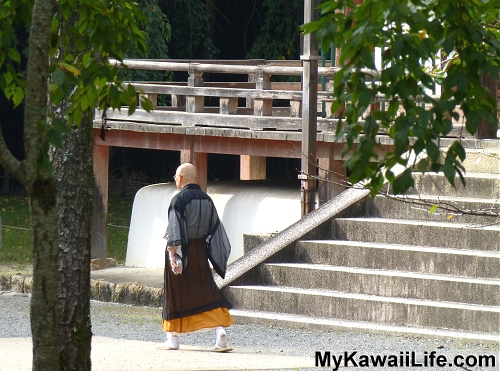Daigoji Temple was the first place we visited on our stay in Kyoto, Japan in 2013. It probably is not the top of the ‘must see’ list for most visitors to the region, but as we had been to Kyoto several times before, we wanted to see some of Kyoto’s lesser known temples. And it turned out to be a pleasant surprise.
Daigoji is actually quite a large complex located on the side of a mountain a little southeast of Kyoto. It is made up of lower grounds (Shimo-Daigo) and upper grounds (Kami-Daigo). Sadly, we were not able to see it all as we didn’t get there until about 3pm (we had landed in Tokyo at 7am that morning and had spent most of the day on trains to get to Kyoto).
We only saw some of the lower grounds. We would have loved to see the upper grounds but the trail up takes about an hour to walk and we just did not have the time.
*** Warning: There are LOTS of photos in this blog post ***
Getting to Daigoji Temple
Getting to Daigoji Temple is quite easy. First, we took a train from Kyoto Station to Yamashina Station. It took about five minutes. We then walked to the Yamashina Subway Station (it’s right next to the JR station) and took the subway on the Tozai Line to Daigo Station. This train took about ten minutes.
From Daigo Station, you can walk to Daigoji Temple if you wish. It is supposed to take 20-30 minutes. We opted for the bus.
The Daigo Community bus runs from the station to Daigoji Temple and back again. The bus stop is right outside the station so it is easy to find. It costs 200Y for a single trip or 300Y return. They run every 20 minutes, so you never have to wait too long for a bus to arrive.
The biggest problem with taking the bus is knowing where to get off. The easiest thing is to just ask the driver to tell you when you reach your stop. Or you can do what we did – look a bit lost. Lol. Whenever we look lost in Japan, a kind Japanese person always comes to our rescue. That’s exactly what happened on this bus. A lovely lady guessed where we were going and told us where to get off and then the bus driver showed us where the bus stop was for when we wanted to go back to the station.
This is the bus stop outside the temple (for when you want to return):
If you are visiting Daigoji, you might like to stop at the store across the road and pick up a drink or some food (especially if you are heading for the upper grounds) before you enter.

To enter the grounds, you first pass through the outer gate.

You will then find yourself following a long straight path up to the next gate and the entrance to the lower grounds. As you walk along this path, you will notice buildings to the left and right of you. To the left is Sanboin Temple, which is famous for its garden and to the right is Reihokan, a museum. Both require separate admission tickets.

Sadly, we did not have time to explore either of these areas. Instead, we headed straight for Niomon, the gate to the lower grounds.

Shimo-Daigo – The Lower Grounds
Just inside the gate is where you purchase your entry tickets. Entrance to the lower grounds is 600Y each. If you have more time, you could also purchase combination tickets (1000Y for the lower grounds and Sanboin or 1500Y for the lower grounds, Sanboin and the Reihokan Museum).

The walk into the grounds is very peaceful. You will find yourself on a path surrounded by trees. If it’s quiet, it’s a nice place for spotting butterflies.
At the end of the path, you will see a large building. This is Kondo, the central hall of the Daigoji complex. It was originally built in 926, but has burnt down twice. The current version was relocated here in 1599. It has been designated a national treasure of Japan and is home to the main object of worship at Daigoji, an enshrined statue of the healing Buddha.

Nearby, you will find several other buildings and shrines.

The one below is dedicated to the local deity, Seiryu Gongen. It was built in 1517. It plays an important role in events surrounding cherry blossom season at Daigoji.

What I like about Daigoji Temple, and, in fact, about most temples in Japan, is that they are still in use. There are still people honouring the traditions and culture of these wonderful places and allowing travellers like us to come and experience them for ourselves.

Perhaps the most important structure you will find at Daigoji is Goju-no-to, a five-storey pagoda. It was built in 951 and is the oldest wooden structure in Kyoto. Like the Kondo, it has been designated a national treasure of Japan.

While we enjoyed looking around all of these cultural assets, what we really came to see was the Bentendo Hall and Daigoji’s most scenic spot. You find it by walking up the hill to the top of the lower grounds.

I could have sat looking at this scene for hours. It was just so peaceful and quiet. I think the turtles agreed with me.

The Bentendo Hall is the small structure overlooking the pond. It is dedicated to the goddess of knowledge and liberal arts (like music).

You can walk right up to the Bentendo Hall by crossing the bridge.

The whole area is just beautiful. Even around the back of the Bentendo area you will find another pond amongst the greenery and a small waterfall. Being late in the day, there were also very few people around so we were able to really relax and take it all in. Sadly, we couldn’t stay as long as we would have liked as it was getting late in the day and it wasn’t long until closing time.
Our visit to Daigoji was a wonderful way to begin our stay in Japan. Perhaps one day we will return and make the climb to the upper grounds.




By Place To Visit In Kyoto Japan #kyoto #japan #travel | A Listly List January 31, 2014 - 8:09 pm
[…] Daigoji Temple, Kyoto […]